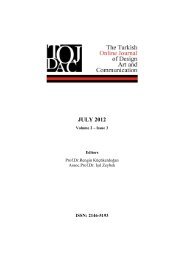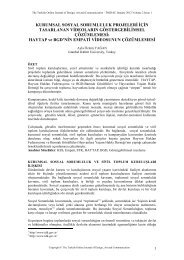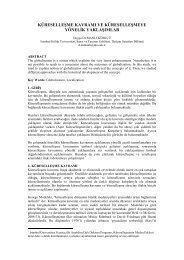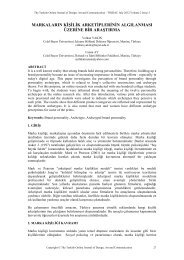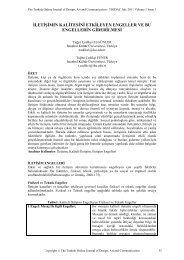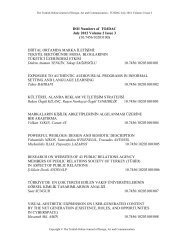aprıl 2012 - tojdac.org
aprıl 2012 - tojdac.org
aprıl 2012 - tojdac.org
You also want an ePaper? Increase the reach of your titles
YUMPU automatically turns print PDFs into web optimized ePapers that Google loves.
The Turkish Online Journal of Design, Art and Communication - TOJDAC April <strong>2012</strong> Volume 2 Issue 2<br />
live, or fighting against existence. And it is there that lies the mystery: if images must not be a<br />
destiny (such as reality could be to man), man has to take care of himself in order to discover<br />
himself and to bloom. In realistic films, bodies express their suffering and make the viewers<br />
react; this is why they cannot be sentimental. Sentimentalism, just like morbid pity<br />
anesthetizes the viewer instead of urging him to act. There is no indulgence in suffering in the<br />
image. Bodies are never mute; they scream their outrage.<br />
The body is a reflection of the relation between man and world. For example, a sick body<br />
reveals a malaise that is also a rupture between oneself and reality; in their movie, The Son,<br />
directed in 2002, The Dardenne Brothers show us that “salvation” is necessary and that it is<br />
possible through the recognition of others and with others. Olivier, a carpenter who works as<br />
an employer at a rehab Center, happened to take his son’s murderer as an apprentice, by<br />
chance. The relation that grows between the two men is ambiguous, and Olivier is definitely<br />
divided between hatred and f<strong>org</strong>iveness. The violence that exists between the two is created<br />
through a physical distance produced by an optical figure: the lack of depth of field secludes<br />
each character in his own external and internal space. Olivier’s body is massive, strong and<br />
always dynamic; the camera follows his movements and his restless breathing. In this cruel<br />
situation, it looks like that there is no place and no way to be at peace. Dardenne Brothers hate<br />
the idea of a fatalist void as a human condition. They believe that man has the possibility of<br />
finding oneself, and this capacity is sacred: for example, even if f<strong>org</strong>iveness is transcendent<br />
feeling, it is a real liberating process. In any case, “salvation” is essentially terrestrial since it<br />
must happen in the “here and now” and not on a transcendental level. The way in which the<br />
bodies are filmed, without ever being overwhelmed, emphasizes the idea of the body as a<br />
mediator between reality and desire. Often, behind the characters, the camera does not try to<br />
dramatize the action using emotions. The Dardennes Brothers refuse stereotype and respect<br />
reality and its mysteries. The world’s ambiguity, so important to Bazin, should be present in<br />
the image and leave the viewer interpret what he sees, in his way, with his subjectivity.<br />
Figure 3. Olivier and Francis, in The Son, Dardennes Brothers, 2002.<br />
With realism as revealing of the sacred, the image changed its status: it is no longer perceived<br />
as a simulacrum but on the contrary, it brings into mind of a transcendental expression in its<br />
purest form, turning into its referent. Cinematographic realism sets man in the heart of the<br />
world and provides him with a right relation. The trivial, death and the meaning of existence<br />
are themes that re-establish a link with spirituality, based on the conception that the human<br />
being lives through its body and has a profound relationship with everything that surrounds<br />
him. Gilles Deleuze showed that the body is a truly mediator between reality and time because<br />
it manifests the experience of life [4].Contemporary film and video are each time more<br />
Copyright © The Turkish Online Journal of Design, Art and Communication 20



